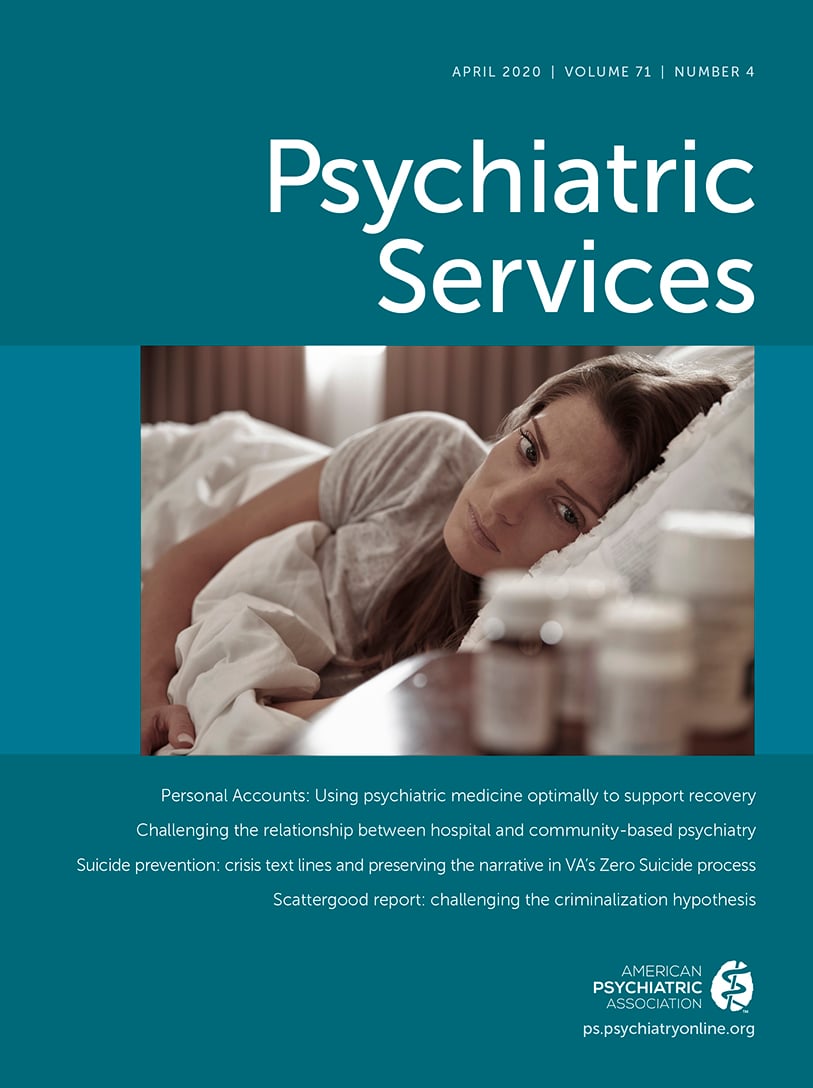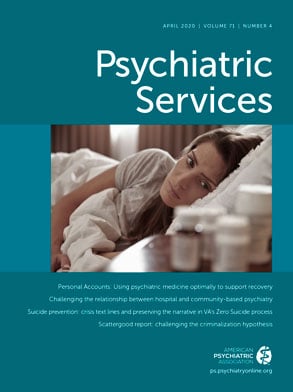Approximately 21 veterans die from suicide every day (
1). The U.S. Department of Veteran Affairs (VA) has implemented several programs and appropriately diverted significant resources to change this alarming statistic. For example, the Veterans Crisis Line (1–800–273–8255 [TALK]) was established in 2007, and in 2011, counselors began staffing an online chat forum (
www.veteranscrisisline.net); the Center of Excellence for Suicide Prevention has operated in Veterans Integrated Service Network (VISN) 2 since 2007; and researchers study suicide prevention at the Rocky Mountain Mental Illness Research, Education and Clinical Center in VISN 19. Within each of the 145 VA hospitals, a suicide prevention coordinator is responsible for overseeing the Veterans Health Administration (VHA) suicide prevention policies and programs (
2). These responsibilities include oversight of the High Risk for Suicide List and of the new Recovery Engagement and Coordination for Health—Veterans Enhanced Treatment (REACH VET) programs (
3). Both initiatives require increased contact between veterans and a behavioral health clinician. Additionally, the High Risk for Suicide List ensures that a “flag” is placed on the veteran’s medical chart to notify all VHA staff to discuss suicide risk factors and prevention methods with the identified veteran, ideally at each clinical contact. More recently, the VA has expanded partnerships with the broader health care community and the media to help reduce the number of deaths by suicide among veterans.
Despite internal VA efforts and expanding collaborative interventions outside of the VA, the data on suicide risk and suicide rates in the veteran population continue to be very troubling. In 2016, the VA’s official blog reported on conducting “the nation’s largest analysis of Veteran suicide” and highlighted that
since 2001, U.S. adult civilian suicides increased 23 percent, while Veteran suicides increased 32 percent in the same time period. After controlling for age and gender, this makes the risk of suicide 21 percent greater for Veterans. Since 2001, the rate of suicide among U.S. Veterans who use VA services increased by 8.8 percent, while the rate of suicide among Veterans who do not use VA services increased by 38.6 percent (
4).
It is important to emphasize the partial success—the comparatively lower suicide rate—for veterans using VA care and to highlight that over two-thirds of veterans who died by suicide during the study period had not recently received care from the VA (
1).
Reducing veteran suicide, even aiming for zero suicides, is a necessary, worthy, and aspirational goal. As behavioral health clinicians within the VHA system, we recognize the importance of facing this problem head on, leveraging any available scientific evidence as well as fiscal and personnel resources to assist veterans struggling with suicidal ideation and behavior.
A primary difficulty that clinicians currently face, however, is that some VHA policies are burdensome and lack consistently robust evidence in the supporting literature for broad implementation (
5). This difficulty is often coupled with implicit expectations and pressure to effect change without additional support, resources, or time.
For example, within the past year, the suicide risk evaluation procedures changed throughout the VHA (
6). Clinicians are now expected to complete at every initial clinical contact a standardized comprehensive evaluation for certain patients that takes 30−45 minutes or longer. This evaluation is required even when validated screening instruments have provided negative or noncompelling results and when the comprehensive evaluation is not clinically indicated and would not add meaningful information or assist in needed safety planning. Such cases include when the information in the comprehensive assessment has already been addressed; when the presenting complaint, history of present illness, and psychiatric and general medical history do not warrant a comprehensive evaluation; when a patient who is well known to an established clinician presents with baseline passive suicidal ideation without intent or plan, and many of the elements contained in the comprehensive evaluation are already known and are active elements of treatment; and/or when the evaluation may actually interfere with rapport building and tailored, personalized crisis management. With the implementation of well-intentioned suicide prevention strategies such as this, the VA may be running ahead of what the current data support and may risk other unintended consequences.
Clinician burnout may be an important unintended consequence of policies that are poorly matched with resources. Zero Suicide initiatives, including those within the VA, aim to develop a nonjudgmental culture in which clinicians honor the dialectic that while we strive for zero suicides, in many instances such results may be out of our control (
7,
8). An incomplete understanding of this aim and a rigid adherence to an oversimplified conceptualization of what suicide prevention work entails can lead to policy decisions that are out of sync with clinical realities. One might even suggest that some policies are more “Congress based” than evidence based, in that their origins seem to be driven by political pressures rather than by medical best practice with strong evidentiary support. From the physician burnout literature, we understand that predictors of burnout include “excessive workload, clerical burden, and inefficiency in the practice environment [and] loss of control over work” (
9). All of these factors are present when bureaucratic demands outstrip resources and evidence. Increased expectations without increased support or resources further augment the common and well-understood toll already exacted by working with patients at high risk for suicide. An additional factor contributing to potential burnout, perhaps unique to the VA, is the mandate to provide same-day access to any veteran with a behavioral health chief complaint (
10) while continuing to measure clinical performance and productivity (at least for physicians) in relative value units (RVUs). Maintaining open appointments (such as in validated collaborative or integrated care models to address same-day needs), particularly for suicidal patients and others in crisis, and meeting the pressure to maintain full clinical schedules to meet RVU standards are perennial challenges across health care settings, including the VA.
The erosion of the clinician-patient relationship may be a second important unintended consequence of current policy. Eliciting patient-generated narratives is important for a more accurate understanding of the unique drivers of suicidal crises and overall risk. Furthermore, these narratives are indispensable for the creation of meaningful and effective treatment interventions and safety planning (
11). Evidence suggests that even brief narrative-driven interventions can be effective and cost efficient (
12). Patient stories are fundamental to the work we do as behavioral health clinicians. Many of the tools we use for screening and risk assessment emphasize a narrative approach to suicide prevention, but poor implementation (due to time constraints, lack of training, and even overuse of the screening tools dictated by policies that demand inappropriate implementation) can undermine their original intent.
If we approach our work with suicidal patients in a bureaucratic, policy-driven, and overly regimented manner, we risk adopting the reductionist view that screening instruments and standardized assessments are sufficient to reduce veteran suicide. We certainly applaud the appropriate and widespread use of robustly validated assessment measures. At the same time, we recognize that behavioral health clinicians are uniquely trained not just to administer screening tools and scripted assessments but to engage with patients in eliciting a meaningful personal narrative to guide individualized treatment. We cannot afford to abandon our training in favor of mandated implementation of unvalidated or inadequately validated screening and assessment measures alone. Nor can we afford to avoid the standardized tools and assessments that meet clinical standards and simply proceed with care as usual. Clearly, we need a balance of both—the use of validated tools and the freedom to use our clinical skill in listening to our patients and helping them tell their stories.
At no time in human history has there ever emerged compelling evidence that we can eradicate suicide, and no comprehensive and effective strategy exists to wholly eliminate suicide for the veterans we serve. The best data indicate that as we work toward more effective management of suicidal patients, our work will include dynamic, multimodal, multilevel systemic interventions and an increasing emphasis on primary prevention without jettisoning our commitment to our patients’ stories (
11–
14). Suicide is a problem of humanness, not solely of health care. If clinicians are to curb the rising tide of veteran suicide, we would be wise to avoid reductionism. And as we expand and celebrate the social collaboration and systemic changes in the delivery of care to our honored veterans, let us not forget that perhaps the richest experience we can share as humans is story. The narratives our patients entrust to us will necessarily continue to guide our care even as we further develop and implement validated and standardized evaluation and treatment tools.

